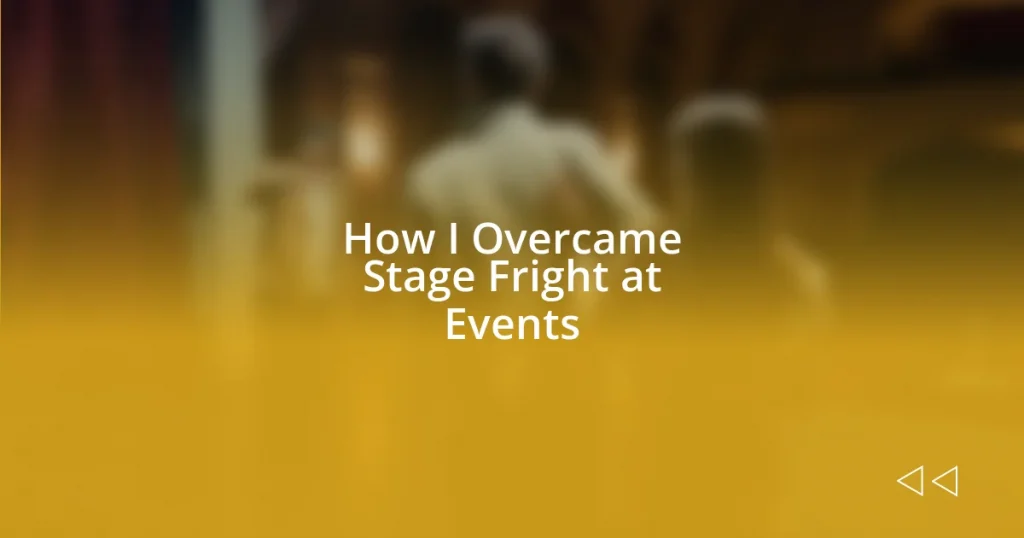Key takeaways:
- Recognizing and understanding stage fright symptoms, such as rapid heartbeat and cold hands, is crucial for overcoming anxiety in public speaking.
- Developing a consistent pre-event routine, including deep breathing, visualization, and positive affirmations, significantly helps to calm nerves and enhance confidence.
- Engaging with the audience through eye contact and interactive elements transforms the presentation experience from a performance into a meaningful conversation, boosting both confidence and connection.

Understanding Stage Fright Symptoms
When I first faced an audience, my heart raced like it was trying to escape my chest. This rapid heartbeat, a classic symptom of stage fright, often makes us feel like we’re in a fight-or-flight mode. Have you ever felt that same fluttering panic as you stood in front of a crowd? It’s a universal experience that can sometimes feel isolating, yet so many of us know this feeling all too well.
As I stood backstage, my hands grew cold and clammy, a physical reaction that can catch you off guard. It’s fascinating how our bodies respond to anxiety—like tiny indicators of our nervousness. Do you remember feeling that trembling in your legs or the dryness in your mouth? These bodily symptoms serve as stark reminders of the performance pressure we place on ourselves.
One time, I couldn’t shake off the feeling of nausea as I prepared to speak. It was as if my stomach was waging its own war against me. I started to wonder if these physical symptoms were not just signs of fear but also markers of an opportunity for growth. Recognizing and understanding these symptoms is the first pivotal step toward overcoming stage fright, and it can truly transform how we approach public speaking.

Identifying Personal Triggers for Anxiety
Identifying personal triggers for anxiety is a deeply personal journey. For me, certain situations, like the size of the audience or the formality of the event, would amplify my feelings of unease. I remember feeling particularly anxious at a large conference where everyone seemed to know each other. It didn’t take long for that uncomfortable sensation of being an outsider to settle in, reminding me how critical it is to pinpoint what heightens my anxiety in similar settings.
I’ve learned that environmental factors play a huge role in my anxiety levels. For instance, the buzz of a crowded room often heightens my senses, making my heart race even more. When I gave a speech surrounded by unfamiliar faces, the noise and energy felt overwhelming, almost suffocating. In contrast, smaller, more intimate gatherings brought me a surprising sense of calm. This stark difference has taught me that identifying and adapting to my triggers can make all the difference.
Reflecting on past experiences allows me to understand my reaction patterns better. I vividly recall a moment at a community event when a sudden technical issue occurred, and I froze. That unexpected glitch triggered a cascade of anxiety that left me feeling vulnerable. Acknowledging that a lack of control can ignite my nerves empowers me to prepare better for unforeseen challenges in future presentations, turning potential anxieties into manageable situations.
| Trigger Type | My Response |
|---|---|
| Large Audience | Increased anxiety, feeling of isolation |
| Small Group | Greater comfort and confidence |
| Crowded Environment | Overwhelmed by energy |
| Technical Issues | Increased vulnerability and panic |

Developing a Pre-Event Routine
Developing a pre-event routine has been a game-changer for me. I found that establishing consistent habits before stepping onto the stage significantly calms my nerves. I remember one evening before a big presentation, I sketched out my routine, which felt like creating my own personal safety net. It included everything from deep breathing exercises to a little visualization, picturing myself speaking confidently in front of the audience.
Here are some elements that have worked wonderfully for my pre-event routine:
- Deep Breathing: I take several slow, deep breaths to center myself.
- Visualization: I imagine a successful event while picturing the audience reacting positively.
- Positive Affirmations: I repeat encouraging statements, reminding myself of my capabilities.
- Dress Rehearsals: I practice my speech aloud, as if I were in front of the crowd.
- Hydration: I always keep a glass of water handy; it helps with my dry mouth and calms my nerves.
Through trial and error, I’ve learned that maintaining a routine puts me in a focused mindset. Before I speak now, I pull on the soft sweater I wore the last time I presented successfully, a little gesture that connects me to that past victory. It’s all about creating rituals that convert anxiety into excitement, and that’s become central to my preparation process.

Practicing Effective Breathing Techniques
Practicing effective breathing techniques has been transformative in my quest to overcome stage fright. Whenever I feel that familiar knot in my stomach, I pause to take a moment for myself. In my experience, a simple deep breathing exercise can ground me in an instant. By inhaling slowly through my nose for a count of four, holding it for a moment, and then exhaling through my mouth for six, I create a calming rhythm that breaks the cycle of rising anxiety. Have you ever tried this? It’s remarkable how such a small practice can change the atmosphere in my mind from chaos to clarity.
I vividly recall a time when I stood backstage, heart pounding, about to present at a workshop. Instead of succumbing to that wave of panic, I closed my eyes and began my breathing routine. I could feel the pressure of the crowd fade, replaced by a serene focus. The power of breath is an underestimated ally; I’ve found that switching from shallow chest breaths to deep abdominal breathing not only calms my nerves but also enhances my voice projection. What’s fascinating is how it impacts my confidence. When I breathe fully, my body intuitively responds by standing taller and feeling more assertive.
As I’ve continued to refine my approach, I’ve come to appreciate how breathing techniques not only help me on stage but also in everyday stressful situations. For instance, during a particularly hectic week filled with deadlines, I revisit my breathing practices, often reclaiming a sense of peace amid the chaos. It’s almost meditative. Incorporating these techniques into my daily routine has created a steady foundation of calm that I can draw upon anytime. It’s a simple yet profound reminder: mastering breath is about mastering oneself.

Using Visualization for Confidence
Visualization has truly been a powerful tool in my journey to overcome stage fright. I often take a quiet moment to close my eyes and picture myself on stage, speaking with poise and passion. It might sound a bit cliché, but the vivid imagery of an applauding audience really ignites a spark within me. Have you ever imagined your successful moment so clearly that it felt almost tangible? That’s the magic of visualization—it allows me to mentally rehearse happiness and confidence before I actually step into the spotlight.
One instance comes to mind when I had a crucial presentation that could change my career path. Instead of focusing on the potential disasters in my mind, I decided to visualize every detail: the lighting, the supportive faces in the crowd, and my own confident smile as I delivered my main points. When I walked into the room, that mental rehearsal resonated deep within me. I felt like I had already succeeded, and in that moment, I realized how profoundly visualization can reframe fear into anticipation.
As I think back on this practice, I’ve noticed it has built a kind of emotional armor around me. By visualizing success, I embrace my nerves rather than run from them. I’ve learned that confidence isn’t purely about the absence of fear; it’s about feeling the fear and choosing to move forward anyway. What if the next time you face an audience, you created an entire movie in your mind about how amazing it could be? You might just surprise yourself with how that belief shapes your reality.

Engaging with Your Audience
When I engage with my audience, I’ve found that making eye contact creates an immediate connection that can dissolve anxiety. Instead of seeing a sea of faces, I focus on one person at a time. This shift in perspective helps me feel grounded; it transforms the experience from a performance into a conversation. Have you ever been drawn into a discussion where you felt truly acknowledged? That intimate exchange makes all the difference.
During one event, I vividly remember locking eyes with a woman in the front row. She nodded encouragingly, and in that moment, my fears faded. I no longer felt like I was speaking to a crowd but rather sharing a story with friends. Recognizing those little expressions of interest or support in my audience gives me a boost of confidence. It’s like finding a warm light in the darkness of stage fright, reminding me that I’m not alone.
To encourage even deeper engagement, I often incorporate interactive elements into my presentation. Whether it’s posing questions or inviting the audience to share their experiences, these moments transform the dynamic. Last year, I tried this approach during a workshop and was amazed by how participants started to open up. Their stories enriched the conversation, making my presentation feel like a collaborative journey. This collaboration not only alleviated my nerves but also created a vibrant atmosphere where everyone felt invested. How do you engage with your audience? Your approach could unlock a whole new level of connection and confidence.

Reflecting on Performance and Growth
Reflecting on my experiences, I’ve come to appreciate how each performance helped me grow in ways I never anticipated. After each event, I take a moment to analyze what went well and what didn’t. It’s almost like reviewing a favorite film—I’m both the viewer and the director, reliving pivotal moments that lead to valuable insights. Have you ever felt a rush of realization as you reflected on your own accomplishments? That feeling can be truly enlightening.
One memorable instance was after a particularly nerve-wracking speech where I stumbled over a few words. Rather than dwelling on the mistake, I shifted my focus to the positive response I received afterward. A few audience members approached me, sharing how my message resonated with them. This shift in perspective taught me that even perceived flaws can lead to genuine connections; I realized that vulnerability can create an unexpected bond. Isn’t it fascinating how often we overlook the beauty in our imperfect moments?
Every time I reflect on these experiences, I notice a tangible shift in my confidence. I’ve learned that growth isn’t linear; it’s more like a series of spirals, where each performance circles back to teach me something new. Embracing the process of reflection has become my secret weapon against stage fright. Do you take the time to reflect on your performances? You might find that understanding your journey is just as empowering as the act itself.















